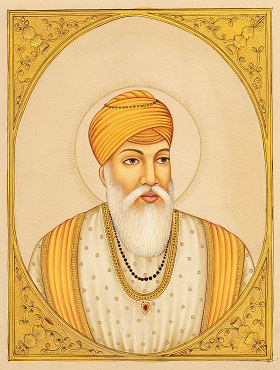
Origins of Third Guru:
Guru Amar Das began life as a devout Hindu. He grew up to be a devotee of the Hindu deity Vishnu. Amar Das married Mansa Devi and had a daughter Dani. His brother, Manak Chand had a son, Jasoo, who had married, Amro, Guru Angad Dev’s elder daughter. At the age of 61, Amar Das overheard Amro singing the hymns of Nanak and became a follower of Sikhism.
Conversion and Succession:
Amar Das presented himself to Guru Angad Dev in Khadur and became an ardent devotee. He carried firewood and water for the guru’s kitchen from Goindwal to Khadur every day. Amar Das had another daughter, Bhani, and two sons, Mohan and Mohri. Guru Angad Dev requested Amar Das to move his family to Goindwal, and stay there nights so that he would have to carry water only once a day to Khadur. Amar Das tirelessly served the Sikh congregation for 12 years. His selfless service earned the trust of Guru Angad, who when he died at age 48, appointed Amar Das, age 73, to be his successor, and third guru of the Sikhs.
Dealing With Adversity:
Angad Dev’s younger son, Datu, claimed the succession for himself and challenged the authority of Guru Amar Das. He told the elder man to leave and then kicked him with his foot demanding how he could be Guru when he had been only an old servant. Guru Amar Das humbly soothed the angry young man replying that his old bones were hard and may have hurt him. Amar Das retreated and shut himself away in deep meditation. He hung a sign on the door giving notice that anyone entering the door was no Sikh of his, nor would be be their Guru. When the Sikhs discovered his whereabouts, they broke through the wall to request their Guru’s presence and leadership.
Contributions to Sikhism:
Guru Amar Das and Khivi, Angad Dev’s widow, worked together to carry on the tradition of langar, free meals served from the guru’s communal kitchen. He decreed that all who came to see him should be first fed and implemented the concept of “pangat sangat,” nourishment of both body and soul, insisting all people sit together as equal without regard to gender, rank or caste. The Guru uplifted the status of women, and encouraged them to discard the veil. He supported remarriage and denounced the practice of sati, a Hindu custom compelling a widow to be burnt alive on her husband’s funeral pyre.
Goindwal:
During his years of service at Goindwal, Amar Das helped to found a township. When he became guru he moved stopped going to Khadur daily and moved to Goindwal permanently. He constructed a well having84 steps on the river bank to serve the people’s needs for water. The guru also established Manjis, or seats of Sikhism, by province. During his lifetime Guru Amar Das penned 7,500 lines of inspirational poetic verse, including Anand Sahib, which later became part of the scripture in the Guru Granth Sahib. He appointed his son-in-law,Jetha, to be his successor and named him Raam Das, meaning “Servant of God.”
Important Dates and Corresponding Events:
Dates correspond to the Nanakshahi calendar.
- Birth: Basarke – May 23, 1479, Amar Das is born before dawn of the 14th day of the waxing moon in the month of Vaisakh to mother, Lakhmi (Bhakat), and father, Tej Bhan.
- Marriage: Sankhatra – January 8, 1503, Amar Das weds Mansa Devi (?-1569), daughter of Devi Chand. They have daughters, Dani (1530), and Bhani (1535-1598), and sons, Mohan (1536), and Mohri (1539).
- Meets Guru Angad Dev: Khadur – 1532, Amar Das hears the hymns of Guru Nanak, meets Guru Angad Dev, and becomes a devout follower of Sikhism.
- Inauguration as Guru: Khadur – April 16, 1152, Guru Angad Dev appoints Amar Das his successor.
- Establishes Goindwal: 1559, Guru Amar Das constructs a well with 84 steps.
- Death: Goindwal – September 16, 1574, Guru Amar Das appoints Bhani’s husband, Jetha, his successor and names him Raam Das.
Guru Amar Das Ji was the third Guru of Sikhism, known for his significant contributions to Sikhism and society. Here’s a summary of the key details:
- Name: Guru Amar Das Ji
- Father’s Name: Bhai Tej Bhan
- Mother’s Name: Mata Sulakhani
- Date of Birth: May 5, 1479
- Place of Birth: Village Basarke, Dist. Amritsar
- Spouse Name: Bibi Mansa Devi
- Children’s Names: Baba Mohan, Baba Mohri, Bibi Dani, Bibi Bhani
- Accession to Gurgaddi (Guru Position): 1552 at Khadur Sahib
- Cities Founded: Govindval on the banks of river Bias in 1552
- Banis (Hymns): 907 hymns in 17 Ragas, including Sri Rag, Asa, Majh, Gujari, Sorathi, Gauri, etc. He also recited Anand in Rag Ramakali in 1554 A.D.
- Contemporary: Emperor Akbar (1556 – 1605)
- Message: Guru Amar Das Ji advocated for the elimination of the caste system (San and Pars), promoting equality.
- Special Contributions:
- Established 22 centres known as Manjls based on the Mughal system of 22 paraganas.
- Revitalized the concept of Langar (community kitchen), making it a vital part of Sikh tradition.
- Persuaded Emperor Akbar to abolish the Jazia tax imposed on non-Muslims.
- Joti Jot (Death): September 1, 1574, at Govindval, Dist. Amritsar.
Guru Amar Das Ji’s leadership and spiritual teachings played a vital role in shaping Sikhism during his time, emphasizing equality, community service, and devotion to God.
